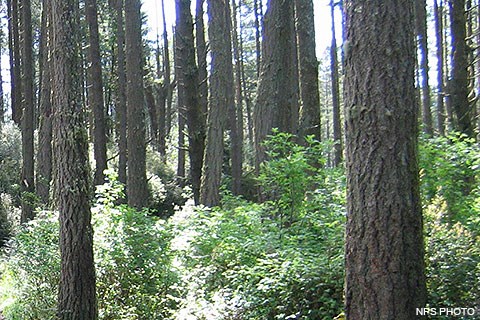|
Douglas fir (Pseudotsuga menziesii)/mixed evergreen forests at Point Reyes National Seashore are found primarily along the southern section of Inverness Ridge (see Vegetation Map). They are found on marine derived sedimentary soils and also experience the coastal influence in the form of summer fog. This forest type is found from southern Oregon to southern California and is typified across its range by the dominance of broad-leaved sclerophyllous species with little to significant coniferous presence. At Point Reyes, the coniferous influence is significant and most mixed evergreen forests in the Seashore are dominated by Douglas fir. This vegetation type comprises over 30,000 acres of the Seashore. 
Douglas fir-dominated forest is characterized by a significant component of hardwood trees, usually California bay (Umbellularia californica), but tanoak (Lithocarpus densiflorus) or individual coast live oaks (Quercus agrifolia) may be present. The shrub understory is highly variable, but is usually moderate to very dense. Coffeberry (Rhamnus californica), huckleberry (Vaccinium ovatum), California hazel (Corylus cornuta), poison oak (Toxicodendron diversilobum) and coyote brush (Baccharis pilularis). Swordfern (Polystichum munitum) often dominates the herbaceous layer. Coast Douglas fir is a large, coniferous, evergreen tree. Trees five to six feet in diameter and 250 feet or more in height are common in old-growth stands. Trees often live more than 500 years. Douglas fir is considered moderately shade tolerant and regenerates best in pasture edges, open areas, and post-disturbance. Further north in its range, Douglas fir stands will give way to shade-tolerant associates such as western hemlock, western red cedar, and Pacific silver fir, but at Point Reyes, it is considered the climax species for the mixed evergreen species assemblage. Coast Douglas fir can survive moderately intense fires. Thick, corky bark on the lower bole and roots protects the cambium from heat damage. In addition, tall trees have their foliage concentrated on the upper bole, which makes it difficult for fire to reach the crown; however, it should be noted that trees are typically not free of lower branches up to a height of 33 feet until they are more than 100 years old. Fire regimes vary greatly over the range of Douglas fir. In Washington and Oregon, Douglas fir often burns in infrequent (>100 years), stand-replacing fires. However, further south in its range, Douglas fir often exhibits a mixed or moderate-low severity fire regime. One study in the Klamath Mountains of Northern California found mean fire return intervals of 12 to 19 years. Researchers looked at the fire history of the Douglas fir forest at Point Reyes. This study was able to obtain cross-dated fire history for two stands dating back to mid-1700s. However, there were relatively few fire occurrences prior to the mid-1800's, which the authors ascribed to missing fire dates. For the period from 1820 to 1905 at one site the median fire return interval was 7.7 years and for the period from 1825 to 1918 at a second site the median fire return interval was 8.5 years. No fires were recorded in this study after 1945. Most fires were recorded on one or a few trees, but were not recorded on all trees in a stand. The authors of this study conclude that, since natural ignition sources are infrequent, these fires were caused by Native Americans or by early settlers. The latter seems more likely given one researcher's conclusion that the Coast Miwok had been extirpated from the peninsula by the beginning of the 1800s. Due to the lack of fires over the last century, there is concern over the encroachment of douglas fir into meadows and coastal scrub. This has been observed in many areas of the Seashore and other parts of the North Coast Range region. Some Douglas fir stands at Point Reyes have substantial ladder fuel accumulations, which could result in crown fire. In particular, the southern section of Inverness Ridge, which was heavily logged during the mid-to-late 1800s, has high fuel loading. Sudden Oak Death (SOD) was first discovered at the Seashore in 2004 and is likely to have a major effect on fuel loadings in this vegetation type. SOD most significantly affects tanoak and tanoaks have been seeing dying along Bolinas and Inverness Ridges in 2005 and 2006. This tanoak dieback is creating significant fuel buildups. More information on the Douglas Fir/Mixed Evergreen Forests Plant Community. Text adapted from the Point Reyes National Seashore's Draft Wildland Fire Resource Advisor Guide (2,436 KB PDF).
Wildland Fire in Douglas Fire |
Last updated: February 5, 2024
